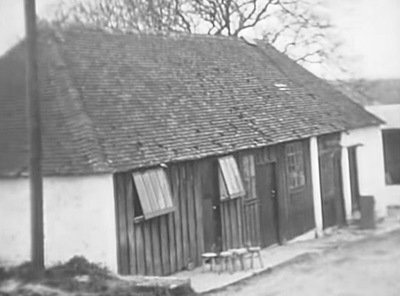Making Trouble-Free Wines poster & seminar day
Published on 22 April 2014
00:00 - 00:00
This year’s Trouble-Free Winemaking Day (on Wednesday 19th March) was an unqualified success. Each second year 2 Vinification Module student was allocated a significant winemaking problem and asked to produce a poster. The posters explained the problems and provided really useful information on how to identify, avoid and rectify them; everything a new graduate winemaker needs to know!
The students then presented their posters to their peers in a break –out session in the foyer of the new UK Wine Research Centre. Guests from industry were invited to participate in the day, observe the quality of the student work and help award prizes to the best students.
The poster winners for 2014 where:
- Alastair Whyte on “Brettanomyces spoilage” – Poster most relevant to the UK wine industry, sponsored by BevTech
- Paul Pippard on “Iron casse” – Poster voted by the students, sponsored by Laffort
- Ian Warborn-Jones on “Biogenic amines” – Most professional presentation, sponsored by IOC
- Hugo Corney “Ethyl carbamate” – Most informative poster, sponsored by Lanxess
- Ian Holloway – Most active conference participant, sponsored by Tony Milanowski
Alongside the poster conference, industry speakers were invited to present on some of the most up-to date research into winemaking developments.
Below are short reports on these presentations, written by the students.
Guy Smith – Bibelot wines “Low and No Alcohol: Why & how?”
Both students and industry professionals listened intently as Guy Smith presented enthusiastically about his latest focus, low and no alcohol wines (or should we say, “grape-based drinks”?). Guy has a wealth of experience in new beverage developments, and although he owns a small English vineyard he confessed to having limited wine-making credentials.
Low alcohol wines already hold a significant place in the UK market-place, they currently represent around 1% of all UK wine sales, which equates to approximately £38M per year (or 7M bottles). Why is that? Besides the obvious lowering of post-boozing fuzzy heads, low/no alcohol wines are clearly healthier for you and can be sold to those keen to join in at social events without the concern of calorie intake. Lowering alcohol can also produce a wine that is more acceptable to quaff when a 14.5% sleep-inducing Grenache doesn’t seem too appealing.
Not sold? What if you learned that wines with alcohol content lower than 5.5% attract half the duty than their full strength cousins? Supermarkets have recently caught up with this tasty loophole, you can find low alcohol wines in all the big stores if you know where to look, and it will save you pounds per bottle. These products will not only lower your calorie intake and dreaded red wine hangover, but will significantly reduce your alcohol outgoings.
A variety of methods are employed to achieve a lower alcohol wine. The most obvious one is to stop a fermentation half-way through. This leaves behind any sugar that the yeast hasn’t consumed, resulting in a lower alcohol. Other techniques include reverse osmosis, which filters out the water and alcohol and modifies the flavour profile. Vacuum distillation (also known as ‘spinning cone’) is another option; this manages to keep the flavour of the wine, but requires a large bank balance (machines cost around £1,000,000) and a certain level of expertise. Lastly, a cocktail-style approach can be used, which involves many techniques from past and present. Using ripe grapes, a half strength wine is made, then natural acids are then added along with grape juice. The result is a higher sugar wine (improving aroma) and low production costs.
So, what were the results? I managed to slurp a wine or two provided by Guy. The first thing I noted was the effort taken to make the bottles look like a full-strength style, you’d be forgiven if you arrived home with a bottle or two after mistakenly buying them. The first I tried was a Sauvignon blanc, and, if I am honest, it was just the same, only a touch sweeter than a Marlborough. I later looked at the label (9% ABV), so pretty much a full-power one anyway (which would explain a similar sweetness to a “full strength” Kabinett I tried last week). The zero percent wine, I have to say, was a touch disappointing. It was a fresh tasting, vibrant, fruity drink, but lacked the complexity I have become so used to in full-strength wines. Alcohol provides much-needed complexity to a wine, if you can ignore the calorie, health, religious, legal and taxation issues!
By Matt Brown, 2nd Year BSc Viticulture & Oenology
John McCabe – LANXESS “Role of DMDC in winemaking”
Our second lecture of the day was brought to us by John McCabe from Lanxess, who informed the audience about Velcorin (trade name for Dimethyl Dicarbonate or DMDC); a microbial control agent used both within the wine and soft drinks industry.
Manufactured in Germany and in commercial use for the last thirty years or so, Velcorin works through the penetration of the cell walls of all/sundry microbiological beasties and disrupting enzyme activity leading to cell death. However, once mixed in acidic solutions it hydrolyses and its poses no longer term presence in the wine.
Due to the density of the substance and the need to control its concentration for proper effectiveness, the addition must be made via a specialised dosing unit, which allows the integration of Velcorin into the wine in the form of a fine mist. The breakdown of Velcorin takes several hours (depending upon the temperature of the host beverage), after which the wine is no longer under its benevolent protection. Therefore addition is generally carried out immediately after a near-finished wine has exited the pores of the final sterile filter, and before it is deposited into bottle, with Velcorin acting as a final insurance policy against microbiological spoilage occurring at this critical stage of packaging. The idea is that it won’t clean-up a dirty wine but it will keep clean wine yeast- and bacteria-free.
The products of Velcorin breakdown consists of methanol and carbon dioxide. We were assured by John that the amount of methanol deposited in a single bottle of wine from Velcorin use would be dwarfed by the amount present in the average apple. I don’t think the amount of residual carbon dioxide was addressed but, presumably it would less than the amount needed to frizzantize your wine. Other benefits of this product include its complete lack of association with any known allergens or GM substances, the fact that it does not have to be declared on ingredient lists (in the case of non-alcoholic beverages) due to its complete breakdown, and a purported complete lack of impact upon the colour/taste/aroma of the finished product. John also explained how it could potentially cut additions of sulphur dioxide to wine by 50%, as the anti-microbiological role would be assumed by Velcorin with only the anti-oxidizing properties of sulphur dioxide still being required.
By Matthew Brass 2nd Year BSc Viticulture & Oenology
Robin Querre – Laffort “White wine fining using new vegetable proteins”
Potato is ready to smash pig’s skin as a key wine fining ingredient. Laffort’s Robin Querre put a powerful case for a new potato protein-based treatment for the clarification of musts and wines, during the annual ‘Making Trouble-Free Wine’ conference at Plumpton College.
Potato protein such as Vegecoll™, he told the budding winemakers, is a tool worth considering because it is an allergen-free wine fining. It’s more sustainable than animal proteins, obviously more suitable for vegetarians and vegans, plus it has high sedimentation and very effective clarification abilities. He likened its molecular mass to egg-white and said it had the highest zeta potential (electrostatic potential in a colloidal system) of all fining agents. All of this, he said, makes it “a very good substitute for gelatine”. Its other advantages included the removal of oxidised phenolic compounds and those susceptible to oxidation, and, in red wines, the reduction of aggressive tannins.
He supported his argument with results from commercial scale experiments carried out in France with Colombard. These showed that 5 g/hl potato-based fining gave better results than 100 ml/hl of liquid gelatine. Plus, it achieved these results in only 30 minutes compared to 90 minutes with gelatine. “The lees were a lot more compact and the resulting wine had more esters and thiols after fermentation when compared to the wine treated with gelatine,” Mr Querre said. There was also a significant improvement in wine colour due to potato-based fining’s ability to remove certain phenolic compounds (catechin and epicatechin), which could oxidise to form quinones, which led to yellow-brown polymerised phenols.
Another test, conducted in Italy, on oxidised Falanghina and Greco juices compared potato-based fining with more traditional products such as bentonite and casein. With the same dosage, settling and clarification were achieved much faster and potato-based fining was also the most efficient in the removal of oxidised pigments in the juice. From other tests on Sauvignon blanc and red wine, he said this fining agent proved to be as effective as other fining agents in its ability to clarify, and does so at a much lower dosage without harming the wine’s structure. With red wine it was also effective on very astringent tannins. It appears that these new fining agents are providing winemakers with more options in winemaking and allowing them to choose the agent which best suits their wine styles and situations
By Chris Boiling FDip Wine Production
Olivier Pillet – Institut Œnologique de Champagne “Nutrition and sulphur compounds: a question of balance “
The fourth lecture of the day was on the subject of ferment nutrition and the formation of sulphur compounds. Olivier first introduced the sulphur compounds that can be produced by yeast such as hydrogen sulphide, mercaptans and disulphides. The metabolic pathway responsible for the formation of these compounds was then discussed. He went on to mention the factors to consider when approaching ferment nutrition, in particular yeast strain dependence and juice composition. He also mentioned that lactic acid bacteria can also produce these compounds.
He then introduced his six key points regarding nutrition. The first point was that a nutrient-deficient ferment can produce reductive compounds. The second point was that yeast consumes nitrogen for different purposes at each stage of fermentation. The initial consumption is for the formation of amino acids needed for growth, and as yeast numbers stabilise, nitrogen is switched from amino acid production to the formation of sugar transport proteins in yeast cell membranes. With nutrition management, he encourages favouring “yeast health” rather than yeast biomass, and that it is best to add nitrogen a third of the way through fermentation to support this. The third point made was that vigorous yeast growth early in fermentation by nitrogen additions can in turn lead to a later nitrogen deficiency. The fourth point was that yeast metabolises amino acids at a slower rate than ammonium suggesting, that an addition of an organic amino acid-rich nutrient would be beneficial through the fermentation. The fifth point was that a nutrient-rich environment can have an effect on positive sulphur compounds found in wine and that selecting an organic nutrient is better at achieving this than diammonium phosphate. The sixth point was that nitrogen does not work alone, and that at different stages of fermentation, other forms of nutrition are required. He suggested that thiamine is best added at the beginning of fermentation, followed by an addition of minerals at the beginning of the growth phase, and the addition of nitrogen at a third of the way through. The IOC product ACTIVIT O was suggested as an alternative to Diammonium phosphate as it provides a more comprehensive and effective nutrition to juice at key stages in fermentation
By Tom Jayne 2nd Year BSc Viticulture & Oenology
Pierre de Caffarelli - Station Œnotechnique de Champagne : “potassium and calcium precipitation, the different solutions”. (Or perhaps “Diamonds are not a wine’s best friend- Combating the ever unpopular tartrates”)
Known as “wine diamonds”, those irksome, crunchy little crystals are about as welcome as bird droppings. They fall out of the wine at the least opportune moments - in the consumer’s refrigerator, just before the gala dinner party or causing the so-called ‘gushing’ (over-foaming) of sparkling wine when opened at home or during disgorgement. Mainly potassium bitartrates (KHT) and calcium tartrates (CaT), they are responsible for these wine faults. These little fragments of abandoned acidity are odourless, tasteless and entirely harmless. De Caffarelli notes that Calcium ion levels below 80mg/L indicated a low risk level and when above 100mg/L, they indicate a high risk of precipitation.
And because consumers apparently get quite annoyed at the presence of tartrate deposits, winemakers since the early days go the extra mile to get rid of them. For decades, the only sure solution was cold stabilisation, chilling wine down to near, or below, the freezing point. It is quite effective, getting rid of nearly any level of KHT instability, and can handle the equally annoying CaT issues at the same time. But the method has its drawbacks: it is costly, using high levels of electricity in the process, as well as leading to a loss of volume of wine of about 5%, and has a relatively large impact on organoleptic properties. Furthermore, at low temperatures the cold wine shows a greater risk of oxidation.
Additives like metatartaric could be added to inhibit the crystal nucleation process, however metatartaric acid is quickly hydrolysed so protection is short lived (dependent on pH and storage temperature). Other products based on yeast mannoproteins are not very successful with sparkling wines according to de Caffarelli and are about 20 times more expensive than other additions (i.e. cellulose gum) with even a higher risk of failure. In the past few years, alternative treatments and new classes of tartrate stabilisers were developed, particularly sophisticated forms of high-tech membrane filtration and electrodialysis that remove the troublesome chemical components.
Finally, in recent years, additions like cellulose gum that disrupt or inhibit crystal formation have been authorised. Eye-watering electricity bills have guided research companies like Station Oenotechnique to develop carboxymethyl cellulose (CMC) products. CMC (e.g. CriStab®) requires perfect homogenisation and careful attention during the application, but positive effects can still be observed after 9 years. CMC inhibits microcrystal nucleation and growth, but is not recommended for red wines because of negative interactions with some pigments.
As with anything else in ‘winedom’, the effectiveness of a given treatment depends on the unique composition of the wine treated. The Station Oenotechnique recommends a set of solutions, which includes new approaches to stop crystals from forming or growing, such as Crème de Tackt® for the complete tartaric stabilisation of wines, by removing the surplus of potassium and calcium in one operation, or CalciStab® for the removal of Calcium ions. This means that less compounds have to be taken out in order to achieve stability, and results in a more natural wine. The products and methods may not seem quite as “natural” as those freezing methods, but, according to de Caffarelli, sensory trials suggest that the wines are more intact.
By Thomas Grundmann, 2nd Year BSc Viticulture & Oenology
Overall a very successful day, with all participants learning more about how to produce trouble-free wines.
Poster awards made possible due to the support of

Explore our history
Since the original 400-acre College farm was bought back in 1919, Plumpton College has certainly seen a lot of changes.

Stay connected
Keep up to date with us online. Give us a like and follow us on:















